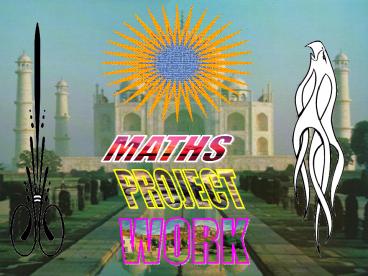MATHS - PowerPoint PPT Presentation
1 / 9
Title:
MATHS
Description:
Maths is used everywhere in the world in fields like shapes, percentage, fraction, symmetry ... Numbers are used in telephones, lockers, houses etc. Shapes ... – PowerPoint PPT presentation
Number of Views:246
Avg rating:3.0/5.0
Title: MATHS
1
MATHS
PROJECT
WORK
2
ADVANTAGES OF MATHS IN DAILY LIFE Maths is used
everywhere in the world in fields like shapes,
percentage, fraction, symmetry Etc.
Numbers Numbers are used in telephones,
lockers, houses etc. Shapes Shapes are used in
buildings, frames etc.
Percentage
Percentage is used in results, bank, shops
etc. Fractions Fractions are used in areas,
distribution etc Symmetry Symmetry is used in
many cases like our body, many shapes, ball etc.
3
Hexagons in nature A honeycomb is an array of
hexagonal (six-sided) cells, made of wax produced
by worker bees. Hexagons fit together to fill all
the available space, giving a strong structure
with no gaps. Squares would also fill the space,
but would not give a rigid structure. Triangles
would fill the space and be rigid, but it would
be difficult to get honey out of their
corners.
4
Fractions of a tomato You can cut all sorts of
fruit and vegetables into fractions cut a tomato
in half, an apple into quarters or a banana into
eighths, although you would have to be very
accurate. An orange might have 20 segments, and
each would be a 20th of the whole orange.
5
Rotational symmetry in a globe A globe is a good
example of rotational symmetry in a
three-dimensional object. The globe keeps its
shape as it is turned on its stand around an
imaginary line between the north and south poles.
The globe shown here dates from the late 15th or
early 16th century and is one of the earliest
three-dimensional representations of the surface
of the Earth. It can be found in the Historical
Academy in Madrid.
6
Understanding percentages Using money is a good
way of understanding percentages. As there are
100 pence in 1, one hundredth of 1 is therefore
1 pence, meaning that 1 per cent of 1 is 1
pence. From this we can calculate that 50 per
cent of 1 is 50 pence. This photograph shows
three British currency notes a 5 note, a 10
note and a 20 note. If 50 pence is 50 per cent
of 1, then 5 is 50 per cent of 10, and so 10
is 50 per cent of 20.
7
Decimal calculator A pocket calculator is one way
in which decimals are used in everyday life. The
value of each digit shown is determined by its
place in the entire row of numbers on the screen.
In this photograph, the 7 is worth 700 (seven
hundreds), the 8 is worth 80 (eight tens) and the
6 is worth 6 (six ones).
8
SYMMETY IN TOWER
9
MADE BY
SAHIL
BOORA

























![Download NCERT Solutions for Class 10 Maths [ Free PDF ] PowerPoint PPT Presentation](https://s3.amazonaws.com/images.powershow.com/9492370.th0.jpg?_=202009160210)





